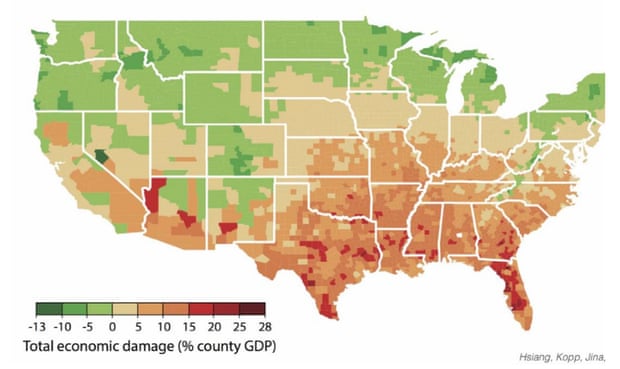
Humans are causing Earth’s climate to change. We know that. We’ve known it for decades. Okay so what? The follow-up questions should be directed to what the effects of warming will be. What will the costs be to society, to the natural biosystem, and to human lives? Let’s be honest, if the consequences of warming are not large, then who cares? But, if the consequences are severe, then we should take action now to reduce the warming. This really comes down to costs and benefits. Are the benefits of reducing emissions greater or less than the costs?
But there is a nuance to the answer. The costs are not uniformly distributed. Some regions will suffer more and other regions will suffer less. In fact, some regions will actually benefit in a warming climate. We understand that the world is interconnected and costs will inevitably be shared to some extent. But it is clear we won’t all suffer the same.
It is also clear that the natural biosystems won’t suffer the same. Some areas are more susceptible to climate change, others less so. Coastal areas and tropical areas are great examples. We know that sea level rise and ocean acidification will impact coastal regions much more than where I live (Minnesota, USA). But tropical zones that experience a very small climate variation throughout the year (there is no winter, for instance, in the tropics) have biosystems that have evolved to survive in very tight climate ranges. The plants and animals just are not used to systematic changes to the climate.
In my opinion, the most interesting research deals with answering just these questions.
Fortunately, a really important paper just came out in Science titled Estimating Economic Damage from Climate Change in the United States. Granted, this paper focused on the United States, but the analysis method and lessons can be applied elsewhere.
So what did they find? First, even in a single country like the United States, the losses will be very uneven. In general, the more southern states will suffer most. In the figure below, counties are colored by economic consequences from climate change under a business as usual scenario. The time period associated with the image is 2080–2099. Yellow, orange and red colors correspond to climate costs. Green colors are areas where climate change benefits will be seen.

Local economic costs/benefits from climate change under business as usual scenario by the years 2080–2099. Illustration: Hsiang et al. (2017), Science.
There are a few takeaway messages. First, the color scale is not symmetric – that is the orange and red values represent pretty large economic losses whereas the green values are notably smaller economic benefits. Secondly, there are more regions that will lose than there are that will win. When interpreting an image like this, we have to be cognizant of the fact that more people live in the Southeast than in the central west. Robert Kopp, one of the authors of the study stated in a press release:
In the absence of major efforts to reduce emissions and strengthen resilience, the Gulf Coast will take a massive hit. Its exposure to sea-level rise – made worse by potentially stronger hurricanes – poses a major risk to its communities. Increasingly extreme heat will drive up violent crime, slow down workers, amp up air conditioning costs, and threaten people’s lives.
This conclusion was echoed by Solomon Hsiang, the lead author:
Unmitigated climate change will be very expensive for huge regions of the United States. If we continue on the current path, our analysis indicates it may result in the largest transfer of wealth from the poor to the rich in the country’s history.
In fact, the authors calculate that the end-of-century temperatures will lead to costs on par with the Great Recession (a recession that will be permanent).
But there is a silver lining that emerges from this study. It helps us plan. By identifying and quantifying the impacts, we can begin to create a social system and even biosystems that are more resilient. Thinking about creation of infrastructure that can withstand flooding along rivers and coasts, developing agricultural methods that are more resilient to heat and droughts, investing in technologies that reduce thermal stresses on humans and animals, reforesting both urban and rural regions to lower local temperatures, etc. The list goes on and on. There are things we can do right now to help our fortunes in the future.
Something should be said about how this study was completed.
Posted by John Abraham on Thursday, 24 August, 2017
 |
The Skeptical Science website by Skeptical Science is licensed under a Creative Commons Attribution 3.0 Unported License. |